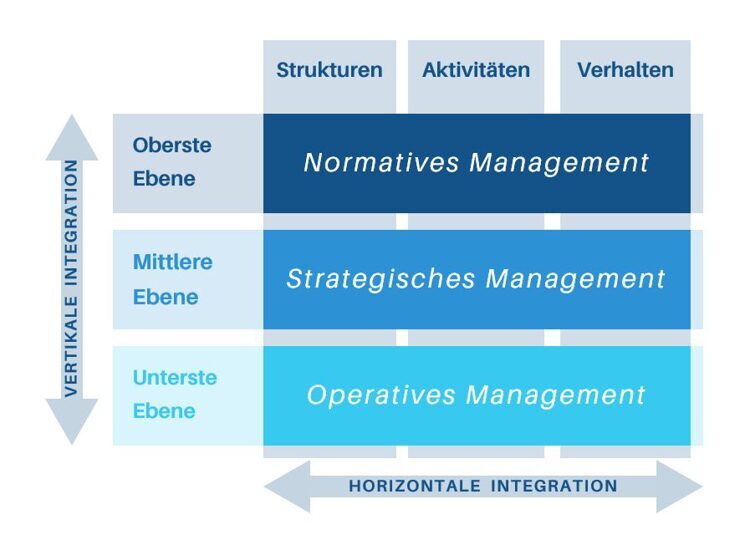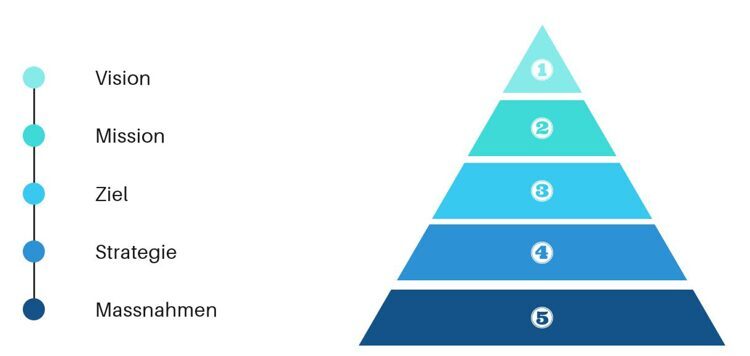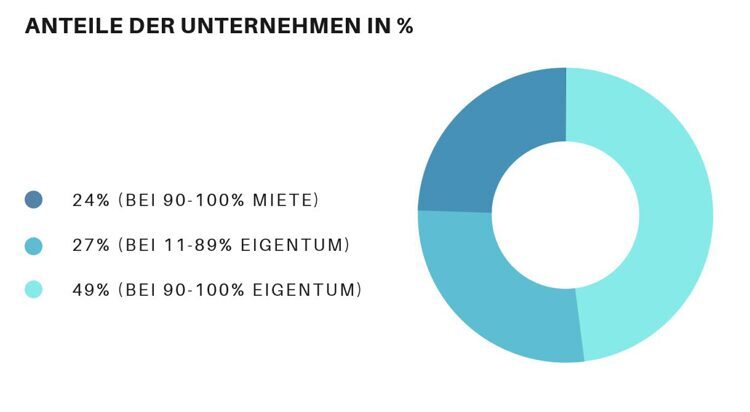Strategic Management in Corporate Real Estate Management | CREM

Is strategy not just a buzzword for you? You are currently dealing with strategic management or have been confronted with this topic for years. The speed of competition and market dynamics as well as changes in internal processes or even the entire value chain bring you more and more frequently into challenging situations?
In this article, you will learn how to integrate the management levels that are necessary for a goal-oriented approach. Furthermore, you will learn which basic elements of a strategy are necessary to ensure future competitiveness and transformation capability.
In order to classify the strategy in the different levels of management respectively their orientation framework, the initial basic ideas of the St. Gallen Management Model (SGMM) developed in the 1980s can be used as a reference framework. This frame of reference is particularly suitable due to the structuring of tasks for corporate management. In the following, the individual management levels and their integration are illustrated and briefly described:

1. normative management
Normative management is understood as the top level and is primarily concerned with the viability and development of a company or division. Nevertheless, this is not only ensured by setting targets, but also by the principles, norms and rules of the game that are geared to success for the entire company. Especially for the CREM area, this level forms an important starting point and defines at the same time their scope of action for the operational real estate management through the recorded purpose of the company, philosophy, vision and culture.
2. Strategic Management
This is followed by strategic management with a planning horizon of five to ten years. This middle level is dedicated to building up, maintaining and exploiting potential for success. For operational real estate management, this often means deriving the actual corporate strategy from the real estate strategy in the best possible way and linking the company's own initiatives to it. Through the so-called functional strategies, the CREM area sets a concrete focus in order to be able to make a successful contribution to the company's competitive strategy.
3. Operational management
Operational management, or the executive body, is the lowest level. It implements the defined normative and strategic goals as well as initiatives of the levels above. The horizontal integration of structures, activities and behavior, as well as the vertical integration of the entire management levels are important for success and form the basis for all possible actions. In particular, this involves business processes with a focus on the optimal provision, management, facility management and utilization of real estate and space (compare ProLeMo+).
"For knowledge itself is power",
has become a catchphrase in linguistics. Even 400 years later, the quintessence of strategic management can still be derived from this succinct formulation. Another parallel can be drawn to the saga of Robin Hood from the 13th century. As is well known, he used his knowledge to develop a strategy which he implemented against the rich. Subconsciously, Robin Hood linked his trend-setting vision of the future to the purpose of his activities and thus formed his goal of standing up for social justice. He derived his subsequent measures, stealing from the rich and handing over the stolen goods to the poor, from his strategy.
However, if strategies are viewed from today's perspective in the corporate environment, one certainly sees many similarities to the application case already described. The term "strategy" is derived from the ancient Greek "strategos". It describes the long-term pursuit of a goal, taking into account the resources and means available. The individual basic elements of strategy can be described as follows:

1. vision
The highest and from the normative management derived element of the strategy describes the vision. It describes the idea to be shaped and also provides the answer to the question of how the company or the division would like to position itself and what scenic character it will adopt in order to be able to realize the holistic benefit intentions. In this context, the vision should act as a kind of slogan in order to stimulate increased commitment among employees. Since CREM often involves the provision of office space, for example, and the company's employees are the focus, a vision could be formulated as follows: Making people happy at work.
2. mission
The second basic element is aimed at the customer's perspective and should primarily describe the benefits and purpose of the company's activities. Here, the why is at the center of the statement. The mission should answer the question: why do we do what we do. To link it to the vision given earlier, a mission in CREM could be stated as follows: We provide a modern workplace concept (New Work) to create a successful environment for all employees.
3. goal
Goals are the subsequent element and indicate the future desired state. Together with mission and vision, these three elements form the basis for the strategy. In the case of the provision of workplaces, this could be formulated as follows from the perspective of the CREM division: With our range of modern office space, we want to positively support the collaboration and successful implementation of our employees' areas of responsibility.
4. strategy
The strategy describes the way into the future. This means that the basic, long-term behaviors are defined and passed on to the next element of measures. Considering current challenges in operational real estate management, this could be summarized as follows: We use proven methods and future-oriented technologies to create real added value for our customers and to drive the digital transformation of our internal value chain.
5. measures
This final element implements the specific activities or initiatives to achieve the defined objectives. The measure names derived from the strategy can be viewed as individual or related projects (program) for further control and steering. The individual measures can be prioritized on the basis of the strategy and mapped by means of a roadmap.

It becomes particularly interesting when comparing the different thrusts of the CREM areas and, in the following example, can at the same time show the market influence of corporate real estate management in the real estate sector.
For this purpose, we can take a closer look at the Corporate Real Estate Sustainability Survey 2010, in which the total area of corporate real estate in Switzerland was determined for the first time. This was made possible by a large number of participating companies and by means of extrapolations. The result of the survey, which was conducted by the Swiss Federal Statistical Office, showed a total area of 238 km2 used and managed by small and large companies. In relation, this corresponds to the equivalent of the total area of the Canton of Zug. Figure 3 also illustrates the ownership structure of company real estate in Switzerland. It is particularly striking that 49% of companies have an ownership ratio of 90 - 100%, which is associated with increased capital commitment but also offers liquidity potential in the event of a possible sale (Waldis, Meins, Golinelli, & Burkhard, 2010, p. 9).
Conclusion: Act successfully into the future instead of reacting.
We hope that the described basic elements of strategic management can support you in achieving your goals. In our opinion, strategies should always act as companions on the way to a successful future and thereby provide the respective direction for the further development of corporate real estate management (CREM) for a company. In addition, it must be supportive in all sections and at the same time serve as a tool to not lose sight of the set goal or to be able to adapt it if necessary. Flexibility and the potential for development also play an important role in order to be able to react to possible market changes or internal changes, for example in processes, at an early stage. The continuous integration of the management levels forms the basic framework. This is particularly important for differentiation at the strategic level and for triggering the strategy process in the best possible way.
So here's my question to you: Do you have any specific real estate strategies in place to optimally counter current market changes, and which initiatives do you prioritize particularly highly? What challenges are you currently facing in particular? I look forward to the exchange.
He is a Senior Consultant specializing in Digital Strategy in the real estate industry and has been able to contribute to various projects across the real estate lifecycle due to his interdisciplinarity. He also actively supports clients in their development of innovative products, services and business models.
How the digital twin will revolutionize the real estate industry.
We have compiled reports on our projects, interesting facts from the various competence and customer areas as well as information about our company for you here. To help you find the relevant articles more quickly, you can filter the news articles by topic.
